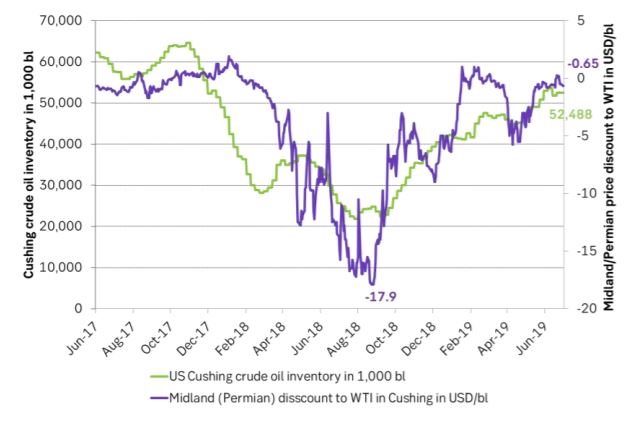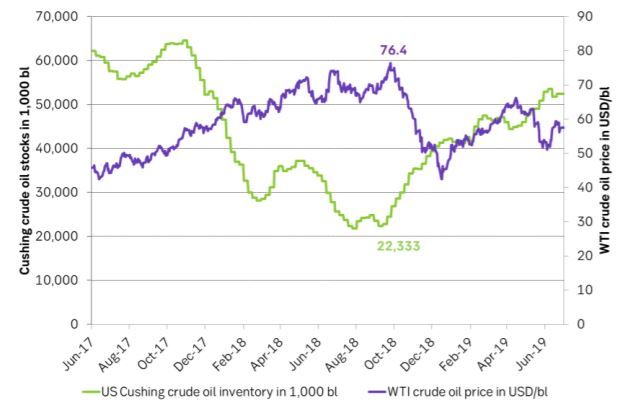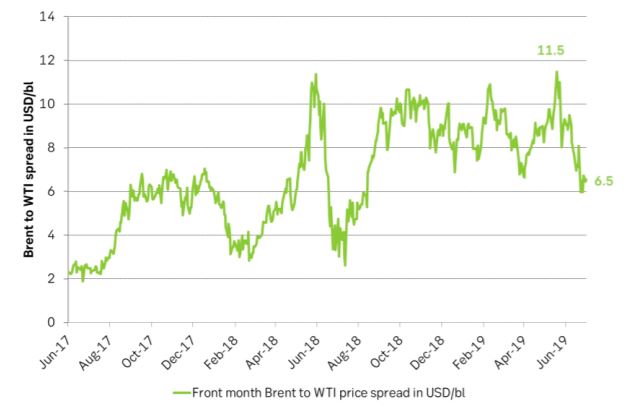Analys
The Permian pipes are coming and it is no small potato


Between 2.2 m bl/d to 2.5 m bl/d of new pipeline capacity from the Permian basin to the US Gulf will be put into operation in a flash of just three quarters (Q3-2019 to Q1-2020). Effective capacity is probably about 1.7 m bl/d to 2.0 m bl/d assuming an 80% utilization rate. The Cactus II (670 k bl/d) from the Permian Basin to the USGC is coming online already the 1st of August. I.e. in only 23 days.
Changes to Texas pipelines had a huge impact on oil prices just one year ago. The Basin/Sunrise pipeline from Midland/Permian to Wichita falls and Cushing Oklahoma then expanded its capacity by a full 500 k bl/d to a total 800 k bl/d. This relieved bulging inventories at depressed prices in the Permian to flow into then very low inventories in Cushing Oklahoma where the WTI is priced. Cushing Oklahoma crude stocks rose strongly, the WTI price crashed, the Brent price crashed and the Midland/Permian price spread to WTI moved from minus $17.9/bl to only minus $0.7/bl today. That is last year’s price action seen from a pipeline perspective.
Now we are set for a much larger change to pipelines in the Permian and it will happen in just three quarters and start already in 23 days.

There has been a significant dislocation between Brent crude oil prices and WTI prices in 2019. The WTI crude curve has been in front end contango while the Brent curve has been in full backwardation and in period exceptionally strong front end backwardation. The two crude curves have told completely different stories. Global Brent market: Too little oil. Local US WTI Cushing Oklahoma market: Too much oil.
When the Cactus II from Wink in Texas (Permian Basin) to Corpus Christi at the USGC (670 k bl/d) comes into operation on 1 August it will release some 4 m barrels from the Permian to the USGC each week (assuming 80% utilization). This will relieve the pressure on other pipelines in Texas. It will for example be much less need to send crude oil from Permian via the Basin/Sunrise pipeline to Cushing Oklahoma. I.e. less crude will flow into Cushing crude stocks from the Permian. It will thus become easier to drain the currently elevated Cushing crude stocks via pipelines to the USGC.
US Cushing crude oil stocks today stands at 52.5 m barrels versus only 22.3 m barrels on the 20th of September last year when the WTI price spiked at $76.4/bl. Cushing is today probably receiving a full flow of crude oil from the Permian Basin via the Basin/Sunrise 800 k bl/d pipeline. At 80% utilization that equals about 4.5 m barrels per week.
This flow of oil from the Permian into Cushing Oklahoma will likely fall partially silent starting 1 August and over the coming three quarters it will definitely fall silent and stop pumping crude oil into Cushing Oklahoma. As the three new pipelines (Cactus II (670 k bl/d), Epic crude (600 – 900 k bl/d) and the Grey Oak (900 k bl/d)) all come online over the next three quarters we might even see that Basin/Sunrise could change direction and help drain Cushing stocks via the Permian to the USGC.
But just halting the flow of oil of about 4.5 m barrels per week from the Permian to Cushing via the Basin/Sunrise pipeline could lead to a decline in Cushing Oklahoma crude oil stocks of 20 m barrels in just one month. That would drag Cushing stocks from 52.3 m barrels today to only 32 m barrels over the course of August alone.
Bullish for WTI and Bearish for Brent. A $2/bl spread is very probable in our view. Needless to say this is bullish for the WTI crude oil curve structure as well as the WTI crude oil flat price. It is also bearish for the Brent crude oil price and crude oil curve structure. The Brent and WTI crude oil price spread will tighten further and the shape of the two crude curves will converge further. Tightness in the global market place will be partially relieved while the WTI market will tighten up significantly.
Will the WTI price move up to Brent or will Brent move down to the WTI price? Global oil producers have enjoyed the luxury of getting a $7.8/bl premium over the WTI price since the start of 2018. The general assumption has been that Brent crude oil will trade in the $60-70/bl range while WTI will trade in the $50-60/bl range. And further that when the new Permian pipelines comes online the next three quarters it will shift the WTI price up towards the global benchmark Brent crude. Or will they maybe meet in the middle or will the Brent crude oil price marker move down to WTI.
We think that the initial action will be a strengthening of the WTI price. The WTI price has over the past 4 years firmly established a price to US inventory relationship. So as US inventories move lower as a result of Permian pipes coming online it will push the WTI price higher on the basis of this established price/inventory relationship.
The Brent crude oil price and curve structure will move towards the WTI curve. The Brent crude curve could move a little lower towards WTI. But a bullish sentiment hitting the WTI price on the back of declining US Cushing crude stocks could even smitten over to the Brent crude oil price and actually lift both the benchmarks. WTI the most and Brent a little.
Our view is that an overweight of global oil investors are hugely focused on the WTI price. Firstly because a large part of them are located in the U.S. Secondly because U.S. oil data are of high quality and published at a high frequency.
It gives a sense of control and that you know what you are doing when you trade WTI on the basis of data you can really trust and see on a high frequency. In other words many oil investors treat the WTI benchmark as THE global benchmark and as a reflection of the global market.
So when US crude inventories decline both in total and locally in Cushing Oklahoma it is taken by investors as a sign of a tightening global oil market even if it in this case is only a shift of oil out of the US and into the global market due to new pipelines coming online from the Permian to the USGC.
Global growth is cooling and oil demand growth along with it but it will likely be countered by an IMO-boost. The global oil market is currently weighted down by continuously deteriorating global growth indicators in combination with still strongly growing US crude oil production. Restraint from OPEC+ and losses of supply from Iran and Venezuela as well as the Russian Druzhba pipeline is helping to prevent oil prices from heading lower and trail the deteriorating global economic growth picture. But elevated US oil inventories and a weak global economic backdrop is preventing oil prices from moving higher.
Global middle distillate demand will likely rise sharply in Q4-19 and H1-20 due to the new IMO 2020 regulations which requires global shipping to consume low sulphur bunker oil. Refineries will have to run hard to meet the added mid-dist demand. We expect this to counter the cooling global growth picture.
H2-19 could see a mix of sharply declining Cushing crude oil stocks and strongly rising mid-dist demand. This could be a very bullish set-up for crude oil prices. Pushing WTI higher on the basis of Cushing crude inventory declines and pulling Brent crude higher on the back of bullish WTI sentiment and strong global mid-dist demand from the shipping side.
Down the road it could be a bit different. WTI would need to move back down to control US shale oil supply growth while Brent crude would follow lower as there would be very little pipeline capacity strains to keep the two benchmarks apart. I.e. we could see WTI back to $55-60/bl and Brent crude only a couple of USD above.
That is of course if we assume that US investors continues to bankroll under-water US shale oil production growth. If US investors demand profits and a positive cash flow from US shale oil producers then WTI would need to move higher in order to keep U.S. shale oil production growing robustly.
More pipelines are coming in 2021. In addition to the 2.2 to 2.5 m bl/d of new pipeline capacity coming online the next three quarters there will be an additional 1.4 to 1.8 m bl/d of pipeline capacity coming online in 2021: The Wink (Permian) to Webster (Houston) 1000 bl/d pipeline and the Seahorse – Tallgrass from Cushing Oklahoma to Louisiana.
What it means is that 1) The Brent to WTI price spread will be narrow over the coming years. 2) That US shale oil producers will receive a crude oil price close to the global price level and the global oil price will stimulate US shale oil production directly without a $7-10/bl discount and 3) That rising U.S. crude oil production will flow freely into the global market place and challenge OPEC+ production in all markets.
US production boom so far has meant declining US oil imports. The effect on OPEC and other non-US producers has been a redirection of oil supply away from the US and instead towards growing demand in Asia. I.e the first phase of the US oil production boom has not been so painful for non-OPEC producers as it primarily has meant a redirection of oil exports.
The next leg of the US oil production boom means US oil exports will challenge non-US producers in the global market. It may be much more difficult for non-US producers to swallow that growing US oil exports challenge them head to head in the global market place. Either stealing all demand growth or even pushing them aside. OPEC+ can probably accept to see their exports at a fixed volume level loosing percentage global market share but with no loss of volumes in absolute terms. But accepting declining volumes in absolute terms is probably a definitely no-go for OPEC+.
This means that US production growth going forward will not be allowed by OPEC+ to grow by more than global demand growth minus production declines (like we have seen in Mexico, China,..).
Ch1: Cushing crude oil stocks were very low one year ago and crude oil was locked up in the Permian basin leading to a very large discount for WTI Midland (Permian) versus WTI Cushing. Then the Basin/Sunrise pipeline expanded capacity by 500 k bl/d to a total of 800 k bl/d in Q4-18. It released oil from Permian to Cushing. Helped to drive Cushing stocks strictly higher and the spread between WTI Midland and WTI Cushing shrank from minus $17.9/bl about in September 2018 to now only minus $0.7/bl

Ch2: As the Cushing crude stocks rose sharply from late September last year the WTI crude oil price totally tanked and dragged the Brent crude oil price lower along with it.

Ch3: The Brent-WTI price spread has moved from a high of $11.5/bl in May last year to now only $5.6/bl. Going forward there will be less and less pipeline constraints and the two grades will move much closer together.

Analys
Fundamentals trump geopolitical tensions

Throughout this week, the Brent Crude price has experienced a decline of USD 3 per barrel, despite ongoing turmoil in the Middle East. Price fluctuations have ranged from highs of USD 91 per barrel at the beginning of the week to lows of USD 87 per barrel as of yesterday evening.

Following the release of yesterday’s US inventory report, Brent Crude once again demonstrated resilience against broader macroeconomic concerns, instead focusing on underlying market fundamentals.
Nevertheless, the recent drop in prices may come as somewhat surprising given the array of conflicting signals observed. Despite an increase in US inventories—a typically bearish indicator—we’ve also witnessed escalating tensions in the Middle East, coupled with the reinstatement of US sanctions on Venezuela. Furthermore, there are indications of impending sanctions on Iran in response to the recent attack on Israel.
Treasury Secretary Janet Yellen has indicated that new sanctions targeting Iran, particularly aimed at restricting its oil exports, could be announced as early as this week. As previously highlighted, we maintain the view that Iran’s oil exports remain vulnerable even without further escalation of the conflict. It appears that Israel is exerting pressure on its ally, the US, to impose stricter sanctions on Iran, an action that is unfolding before our eyes.
Iran’s current oil production stands at close to 3.2 million barrels per day. Considering additional condensate production of about 0.8 million barrels per day and subtracting domestic demand of roughly 1.8 million barrels per day, the net export of Iranian crude and condensate is approximately 2.2 million barrels per day.
However, the uncertainty surrounding the enforcement of such sanctions casts doubt on the likelihood of a complete ending of Iranian exports. Approximately 80% of Iran’s exports are directed to independent refineries in China, suggesting that US sanctions may have limited efficacy unless China complies. The prospect of China resisting US pressure on its oil imports from Iran poses a significant challenge to US sanctions enforcement efforts.
Furthermore, any shortfall resulting from sanctions could potentially be offset by other OPEC nations with spare capacity. Saudi Arabia and the UAE, for instance, can collectively produce an additional almost 3 million barrels of oil per day, although this remains a contingency measure.
In addition to developments related to Iran, the Biden administration has re-imposed restrictions on Venezuelan oil, marking the end of a six-month reprieve. This move is expected to impact flows from the South American nation.
Meanwhile, US crude inventories (excluding SPR holdings) surged by 2.7 million barrels last week (page 11 attached), reaching their highest level since June of last year. This increase coincided with a decline in measures of fuel demand (page 14 attached), underscoring a slightly weaker US market.
In summary, while geopolitical tensions persist and new rounds of sanctions are imposed, our market outlook remains intact. We maintain our forecast of an average Brent Crude price of USD 85 per barrel for the year 2024. In the short term, however, prices are expected to hover around the USD 90 per barrel mark as they navigate through geopolitical uncertainties and fundamental factors.
Analys
Brace for Covert Conflict

In the past two trading days, Brent Crude prices have fluctuated between highs of USD 92.2 per barrel and lows of USD 88.7 per barrel. Despite escalation tensions in the Middle East, oil prices have remained relatively stable over the past 24 hours. The recent barrage of rockets and drones in the region hasn’t significantly affected market sentiment regarding potential disruptions to oil supply. The key concern now is how Israel will respond: will it choose a strong retaliation to assert deterrence, risking wider regional instability, or will it revert to targeted strikes on Iran’s proxies in Lebanon, Syria, Yemen, and Iraq? While it’s too early to predict, one thing is clear: brace for increased volatility, uncertainty, and speculation.

Amidst these developments, the market continues to focus on current fundamentals rather than unfolding geopolitical risks. Despite Iran’s recent attack on Israel, oil prices have slid, reflecting a sideways or slightly bearish sentiment. This morning, oil prices stand at USD 90 per barrel, down 2.5% from Friday’s highs.
The attack
Iran’s launch of over 300 rockets and drones toward Israel marks the first direct assault from Iranian territory since 1991. However, the attack, announced well in advance, resulted in minimal damage as Israeli and allied forces intercepted nearly all projectiles. Hence, the damage inflicted was limited. The incident has prompted US President Joe Biden to urge Israel to exercise restraint, as part of broader efforts to de-escalate tensions in the Middle East.
Israel’s response remains uncertain as its war cabinet deliberates on potential courses of action. While the necessity of a response is acknowledged, the timing and magnitude remain undecided.
The attack was allegedly in retaliation for an Israeli airstrike on Iran’s consulate in Damascus, resulting in significant casualties, including a senior leader in the Islamic Revolutionary Guard Corps’ elite Quds Force. It’s notable that this marks the first direct targeting of Israel from Iranian territory, setting the stage for heightened tensions between the two nations.
Despite the scale of the attack, the vast majority of Iranian projectiles were intercepted before reaching Israeli territory. However, a small number did land, causing minor damage to a military base in the southern region.
President Biden swiftly condemned Iran’s actions and pledged to coordinate a diplomatic response with leaders from the G7 nations. The US military’s rapid repositioning of assets in the region underscores the seriousness of the situation.
Iran’s willingness to escalate tensions further depends on Israel’s response, as indicated by General Mohammad Bagheri, chief of staff of the Iranian armed forces. Meanwhile, speculation about a retaliatory attack from Israel persists.
Looking ahead, key questions remain unanswered. Will Iran launch additional attacks? How will Israel respond, and what implications will it have for the region? Moreover, how will Iran’s allies react to the escalating tensions?
Given the potential for a full-scale war between Iran and Israel, concerns about its impact on global energy markets are growing. Both the United States and China have strong incentives to reduce tensions in the region, given the destabilizing effects of a regional conflict.
Our view in conclusion
The recent escalation between Iran and Israel underscores the delicate balance of power in the volatile Middle East. With tensions reaching unprecedented levels and the specter of further escalation looming, the potential for a full-blown conflict cannot be understated. The ramifications of such a scenario would be far-reaching and could have significant implications for regional stability and global security.
Turning to the oil market, there has been much speculation about the possibility of a full-scale blockade of the Strait of Hormuz in the event of further escalation. However, at present, such a scenario remains highly speculative. Nonetheless, it is crucial to note that Iran’s oil production and exports remain at risk even without further escalation. Currently producing close to 3.2 million barrels per day, Iran has significantly increased its production from mid-2020 levels of 1.9 million barrels per day.
In response to the recent attack, Israel may exert pressure on its ally, the US, to impose stricter sanctions on Iran. The enforcement of such sanctions, particularly on Iranian oil exports, could result in a loss of anywhere between 0.5 million to 1 million barrels per day of oil supply. This would likely keep the oil market in deficit for the remainder of the year, contradicting the Biden administration’s wish to maintain oil and gasoline prices at sustainable levels ahead of the election. While other OPEC nations have spare capacity, utilizing it would tighten the global oil market even further. Saudi Arabia and the UAE, for example, could collectively produce an additional almost 3 million barrels of oil per day if necessary.
Furthermore, both Iran and the US have expressed a desire to prevent further escalation. However, much depends on Israel’s response to the recent barrage of rockets. While Israel has historically refrained from responding violently to attacks (1991), the situation remains fluid. If Israel chooses not to respond forcefully, the US may be compelled to promise stronger enforcement of sanctions on Iranian oil exports. Consequently, Iranian oil exports are at risk, regardless of whether a wider confrontation ensues in the Middle East.
Analyzing the potential impact, approximately 2.2 million barrels per day of net Iranian crude and condensate exports could be at risk, factoring in Iranian domestic demand and condensate production. The effectiveness of US sanctions enforcement, however, remains uncertain, especially considering China’s stance on Iranian oil imports.
Despite these uncertainties, the market outlook remains cautiously optimistic for now, with Brent Crude expected to hover around the USD 90 per barrel mark in the near term. Navigating through geopolitical tensions and fundamental factors, the oil market continues to adapt to evolving conflicts in the Middle East and beyond.
Analys
OPEC+ won’t kill the goose that lays the golden egg

Lots of talk about an increasingly tight oil market. And yes, the oil price will move higher as a result of this and most likely move towards USD 100/b. Tensions and flareups in the Middle East is little threat to oil supply and will be more like catalysts driving the oil price higher on the back of a fundamentally bullish market. I.e. flareups will be more like releasing factors. But OPEC+ will for sure produce more if needed as it has no interest in killing the goose (global economy) that lays the golden egg (oil demand growth). We’ll probably get verbal intervention by OPEC+ with ”.. more supply in H2” quite quickly when oil price moves closer to USD 100/b and that will likely subdue the bullishness. OPEC+ in full control of the oil market probably means an oil price ranging from USD 70/b to USD 100/b with an average of around USD 85/b. Just like last year.

Brent crude continues to trade around USD 90/b awaiting catalysts like further inventory declines or Mid East flareups. Brent crude ydy traded in a range of USD 88.78 – 91.1/b before settling at USD 90.38/b. Trading activity ydy seems like it was much about getting comfortable with 90-level. Is it too high? Is there still more upside etc. But in the end it settled above the 90-line. This morning it has traded consistently above the line without making any kind of great leap higher.
Netanyahu made it clear that Rafah will be attacked. Israel ydy pulled some troops out of Khan Younis in Gaza and that calmed nerves in the region a tiny bit. But it seems to be all about tactical preparations rather than an indication of a defuse of the situation. Ydy evening Benjamin Netanyahu in Israel made it clear that a date for an assault on Rafah indeed has been set despite Biden’s efforts to prevent him doing so. Article in FT on this today. So tension in Israel/Gaza looks set to rise in not too long. The market is also still awaiting Iran’s response to the bombing of its consulate in Damascus one week ago. There is of course no oil production in Israel/Gaza and not much in Syria, Lebanon or Yemen either. The effects on the oil market from tensions and flareups in these countries are first and foremost that they work as catalysts for the oil price to move higher in an oil market which is fundamentally bullish. Deficit and falling oil inventories is the fundamental reason for why the oil price is moving higher and for why it is at USD 90/b today. There is also the long connecting string of:
[Iran-Iraq-Syria/Yemen/Lebanon/Gaza – Israel – US]
which creates a remote risk that oil supply in the Middle East potentially could be at risk in the end when turmoil is flaring in the middle of this connecting string. This always creates discomfort in the oil market. But we see little risk premium for a scenario where oil supply is really hurt in the end as neither Iran nor the US wants to end up in such a situation.
Tight market but OPEC+ will for sure produce more if needed to prevent global economy getting hurt. There is increasing talk about the oil market getting very tight in H2-24 and that the oil price could shoot higher unless OPEC+ is producing more. But of course OPEC+ will indeed produce more. The health of the global economy is essential for OPEC+. Healthy oil demand growth is like the goose that lays the golden egg for them. In no way do they want to kill it with too high oil prices. Brent crude averaged USD 82.2/b last year with a high of USD 98/b. So far this year it has averaged USD 82.6/b. SEB’s forecast is USD 85/b for the average year with a high of USD 100/b. We think that a repetition of last year with respect to oil prices is great for OPEC+ and fully acceptable for the global economy and thus will not hinder a solid oil demand growth which OPEC+ needs. Nothing would make OPEC+ more happy than to produce at a normal level and still being able to get USD 85/b. Brent crude will head yet higher because OPEC+ continues to hold back supply Q2-24 resulting in declining inventories and thus higher prices. But when the oil price is nearing USD 100/b we expect verbal intervention from the group with statements like ”… more supply in H2-24” and that will probably dampen bullish prices.
Not only does OPEC+ want to produce at a normal level. It also needs to produce at a normal level. Because at some point in time in the future there will be a situation sooner or later where they will have to cut again. And unless they are back to normal production at that time they won’t be in a position to cut again.
So OPEC+ won’t kill the goose that lays the golden egg. They won’t allow the oil price to stay too high for too long. I.e. USD 100/b or higher. They will produce more in H2-24 if needed to prevent too high oil prices and they have the reserve capacity to do it.
Data today: US monthly oil market report (STEO) with forecast for US crude and liquids production at 18:00 CET
-

 Nyheter4 veckor sedan
Nyheter4 veckor sedanMichel Rufli om trenderna som får guldpriset att stiga
-

 Nyheter4 veckor sedan
Nyheter4 veckor sedanGuld toppar 2200 USD per uns
-

 Nyheter2 veckor sedan
Nyheter2 veckor sedanGuldpriset når nytt all time high och bryter igenom 2300 USD
-

 Nyheter3 veckor sedan
Nyheter3 veckor sedanLundin Mining får köprekommendation av BMO
-

 Nyheter3 veckor sedan
Nyheter3 veckor sedanVertikal prisuppgång på kakao – priset toppar nu 9000 USD
-

 Nyheter2 veckor sedan
Nyheter2 veckor sedanCentralbanker fortsatte att köpa guld under februari
-

 Nyheter4 veckor sedan
Nyheter4 veckor sedanKaffepriserna stiger på lågt utbud och stark efterfrågan
-

 Nyheter2 veckor sedan
Nyheter2 veckor sedanHur mår den svenska skogsbraschen? Två favoritaktier








